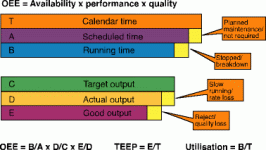

Increasingly more manufacturers are seeking answers to the question of `How to improve production output in a plant?' The obvious answer is to increase capital investment in machinery (assets). The more capital invested in plant and machinery is equal to the increased output of the plant and is thus equal to the rate of competitiveness of the plant. Right? Wrong!
Investing in new plant and machinery will increase the total output of the plant, but the cost per production unit of the plant will dramatically increase. If the current plant machinery does not operate effectively, investing in new machinery will only increase the number of under productive machines in the production lines of the plant. A production lines output is limited by the production of the machine in the line with the lowest production rate.
The answer to the question of 'How to improve production output?' is to utilise each machine (asset) to its maximum potential. By measuring the overall equipment effectiveness (OEE) of the manufacturing process, the efficiency of the process right down to the specific machine or assembly line levels can be measured.
What OEE is
"OEE is a straightforward approach to monitoring and managing the lifecycle of manufacturing assets. OEE is a useful, but still underused metric base on the multiplication of a plant's production rate yield, and utilisation. This metric should be adopted by manufacturers as part of their KPIs and realtime performance management, (RPM) initiatives," according to Craig Resnick, ARC Advisory, group research director.
OEE fist saw the light in the total productive maintenance (TPM) concept used in the Japanese automotive industry in the early '60s. Through the works of Seiichi Nakajima of Nippon Denso the Western world was exposed to this tool more than 15 years ago.
Components of OEE
OEE is a culmination of three factors: availability, performance and quality. For a plant to operate effectively, all the individual pieces of the production equipment and machinery needs to run according to these three measures. Viewing each of these measures on their own they will provide good information about the plant's performance but only when these three measures are viewed together that the true value of OEE will be realised.
Availability
Availability in the OEE context is the actual running time divided by the scheduled running time expressed as a percentage. Actual running time is the scheduled running time minus unplanned stoppages like breakdowns, small stops, set-up and adjustments etc. Scheduled running time is actual time ie, 24 hours times (hour shift minus time allocated for planned maintenance and planned stops like die changes). Scheduled running time is planned before the start of the period or shift.
Performance
Performance in this instance is actual output divided by the targeted output and expressed as a percentage. Actual output is the actual performance of the operation and is less than the targeted output due to rough running of machinery, jams, equipment wear obstructed product flow.
Quality
Quality is expressed as the quantity of product that meets the quality specifications divided by the total production for a specified time period expressed as a percentage.
By measuring OEE in this manner a plant will have a measure of how healthy its production process is relative to its planned production schedule.
Six major losses
OEE is used to identify and eliminate what is called the six big losses of TPM. These losses are responsible for most of the causes of downtime and production losses in a plant. The goal of OEE is to reduce or almost eliminate these six big losses.
Breakdowns and failures (downtime and production loss)
* Tooling failures.
* Unplanned maintenance.
* General breakdowns.
* Equipment failures.
Set-up and adjustments (downtime and production loss)
* Set-up and changeover.
* Material shortages.
* Operator shortages.
* Major adjustments.
* Warm-up time.
Small stops (downtime and production loss)
* Obstructed flow.
* Component jams.
* Misfeeds.
* Delivery blocked.
* Cleaning.
Reduced speed (virtual downtime and production loss)
* Rough running.
* Under nameplate running.
* Under design capacity.
* Equipment wear.
* Operator inefficiency.
Startup rejects (quality loss)
* Scrap.
* Rework.
* In-process damage.
* In-process expiration.
* Incorrect assembly.
Production rejects (quality loss)
* Scrap.
* Rework.
* In-process damage.
* In-process expiration.
* Incorrect assembly.
The cumulative impact that these losses can have on production is evident when it is noted that most production operations operate with OEE scores in the range of 60% to 70%, indicating that most organisations have significant opportunity to improve their OEE and production output.
A 10% OEE improvement
The effect of improving OEE by 10% points, from say 60%-70% the EBIT (earnings before interest and tax or profit before tax) depending upon the terms used by the manufacturer. The R100 million is a loss as it is in brackets, so we are showing that by improving the OEE by 10% it could change around a loss into a profit, making business profitable.
Before OEE increase:
* Revenues R4 bn.
* COG of 56%.
* Gross profit R1,76 bn.
* EBIT R100 million (Loss).
After 10% OEE Increase:
* Revenues R4,4 bn.
* COG 56%.
* Gross profit R1,936 bn.
* EBIT R76 million.
Total profit of R176 million
OEE for manufacturing operations
Before perusing the benefits that can be derived from successfully measuring OEE, the organisations need to make a conscious decision to focus the whole organisation on continuous improvement.
By accurately measuring OEE the problem areas in the organisation will be highlighted. At this point the organisation needs to act on this information and implement deliberate actions to reduce and later eliminate the root causes of these problems. By identifying the causes of lost production and acting on them in a positive way, the hidden potential of all the machines in the plant will be realised and together contribute to the overall increase of production output and competitive advantage of the organisation.

© Technews Publishing (Pty) Ltd | All Rights Reserved